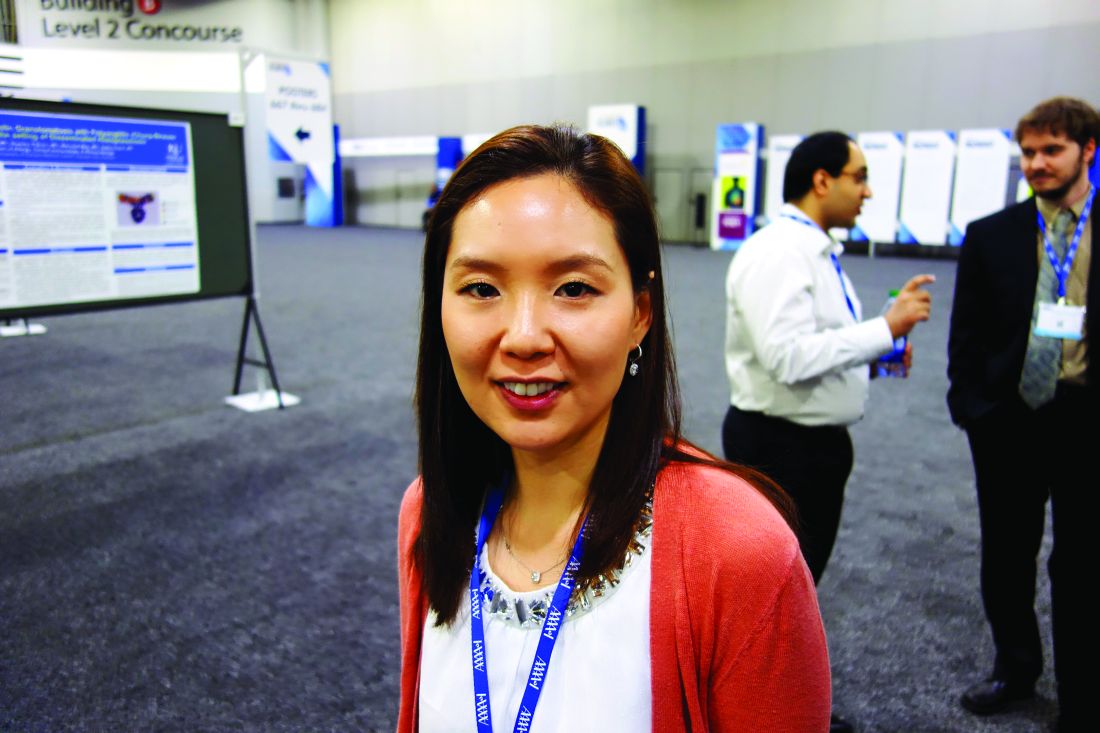User login
ATLANTA – Four hours in the ED are enough to observe most children after anaphylaxis; if they are doing well, they don’t need to be admitted for longer observation, according to Children’s Hospital of Philadelphia investigators.
The right amount of time for observation after anaphylaxis has been debated for years. The current recommendation is 4-8 hours for both children and adults, but it’s a broad range, and some still argue for 24 hours. At least at the Children’s Hospital of Philadelphia (CHOP), much more than 4 hours means that patients need to be admitted to an inpatient floor, or a special extend-care ED unit.
In the fall of 2014, “we decided as a compromise not to go all the way down to 2.5 hours” in the ED, “but to stay within guidelines and go for 4 hours,” so long as kids don’t have asthma or need two epinephrine injections in the ED or have other risks for biphasic reactions, said lead investigator and pediatrician Juhee Lee, MD.
The overall admission rate for pediatric anaphylaxis fell from 58% (106/182) when 8-hour observation was the norm, to 24% (63/257) after ED physicians opted for 4-hour observation in 2014, a near 60% reduction.
Shorter observation was safe; 1% of patients (1/76) came back to the ED within 72 hours before the change, versus 3% (5/194) afterward, a statistically insignificant difference. None of the revisits in either cohort was for severe anaphylaxis symptoms.
“It was surprising to see how significantly we could reduce the admission rate. A 4-hour length of observation appears safe and could drastically improve ED patient flow and decrease hospitalization rates,” Dr. Lee said at the annual meeting of the American Academy of Allergy, Asthma, and Immunology.
About two-thirds of the ED visits in both groups were for food reactions, most commonly peanut and tree nut allergies.
The CHOP ED also changed how its clinicians treat anaphylaxis over the study period. Children used to get antihistamines and steroids in the ED, and were sent home with 5 days’ worth of both. They also left the ED with a prescription for epinephrine, but not an actual autoinjector.
Now, CHOP lets providers decide if children need antihistamines and steroids in the ED, and sends most home with an EpiPen.
Dr. Lee didn’t have any disclosures. There was no outside funding.
ATLANTA – Four hours in the ED are enough to observe most children after anaphylaxis; if they are doing well, they don’t need to be admitted for longer observation, according to Children’s Hospital of Philadelphia investigators.
The right amount of time for observation after anaphylaxis has been debated for years. The current recommendation is 4-8 hours for both children and adults, but it’s a broad range, and some still argue for 24 hours. At least at the Children’s Hospital of Philadelphia (CHOP), much more than 4 hours means that patients need to be admitted to an inpatient floor, or a special extend-care ED unit.
In the fall of 2014, “we decided as a compromise not to go all the way down to 2.5 hours” in the ED, “but to stay within guidelines and go for 4 hours,” so long as kids don’t have asthma or need two epinephrine injections in the ED or have other risks for biphasic reactions, said lead investigator and pediatrician Juhee Lee, MD.
The overall admission rate for pediatric anaphylaxis fell from 58% (106/182) when 8-hour observation was the norm, to 24% (63/257) after ED physicians opted for 4-hour observation in 2014, a near 60% reduction.
Shorter observation was safe; 1% of patients (1/76) came back to the ED within 72 hours before the change, versus 3% (5/194) afterward, a statistically insignificant difference. None of the revisits in either cohort was for severe anaphylaxis symptoms.
“It was surprising to see how significantly we could reduce the admission rate. A 4-hour length of observation appears safe and could drastically improve ED patient flow and decrease hospitalization rates,” Dr. Lee said at the annual meeting of the American Academy of Allergy, Asthma, and Immunology.
About two-thirds of the ED visits in both groups were for food reactions, most commonly peanut and tree nut allergies.
The CHOP ED also changed how its clinicians treat anaphylaxis over the study period. Children used to get antihistamines and steroids in the ED, and were sent home with 5 days’ worth of both. They also left the ED with a prescription for epinephrine, but not an actual autoinjector.
Now, CHOP lets providers decide if children need antihistamines and steroids in the ED, and sends most home with an EpiPen.
Dr. Lee didn’t have any disclosures. There was no outside funding.
ATLANTA – Four hours in the ED are enough to observe most children after anaphylaxis; if they are doing well, they don’t need to be admitted for longer observation, according to Children’s Hospital of Philadelphia investigators.
The right amount of time for observation after anaphylaxis has been debated for years. The current recommendation is 4-8 hours for both children and adults, but it’s a broad range, and some still argue for 24 hours. At least at the Children’s Hospital of Philadelphia (CHOP), much more than 4 hours means that patients need to be admitted to an inpatient floor, or a special extend-care ED unit.
In the fall of 2014, “we decided as a compromise not to go all the way down to 2.5 hours” in the ED, “but to stay within guidelines and go for 4 hours,” so long as kids don’t have asthma or need two epinephrine injections in the ED or have other risks for biphasic reactions, said lead investigator and pediatrician Juhee Lee, MD.
The overall admission rate for pediatric anaphylaxis fell from 58% (106/182) when 8-hour observation was the norm, to 24% (63/257) after ED physicians opted for 4-hour observation in 2014, a near 60% reduction.
Shorter observation was safe; 1% of patients (1/76) came back to the ED within 72 hours before the change, versus 3% (5/194) afterward, a statistically insignificant difference. None of the revisits in either cohort was for severe anaphylaxis symptoms.
“It was surprising to see how significantly we could reduce the admission rate. A 4-hour length of observation appears safe and could drastically improve ED patient flow and decrease hospitalization rates,” Dr. Lee said at the annual meeting of the American Academy of Allergy, Asthma, and Immunology.
About two-thirds of the ED visits in both groups were for food reactions, most commonly peanut and tree nut allergies.
The CHOP ED also changed how its clinicians treat anaphylaxis over the study period. Children used to get antihistamines and steroids in the ED, and were sent home with 5 days’ worth of both. They also left the ED with a prescription for epinephrine, but not an actual autoinjector.
Now, CHOP lets providers decide if children need antihistamines and steroids in the ED, and sends most home with an EpiPen.
Dr. Lee didn’t have any disclosures. There was no outside funding.
Key clinical point:
Major finding: The overall admission rate for pediatric anaphylaxis fell from 58% (106/182) when 8-hour observation was the norm, to 24% (63/257) after ED doctors opted for 4-hour observation in 2014, a near 60% reduction.
Data source: A study of 182 children who underwent 8-hour observation and 257 children who underwent 4-hour observation at the Children’s Hospital of Philadelphia ED.
Disclosures: The lead investigator didn’t have any disclosures. There was no outside funding.

